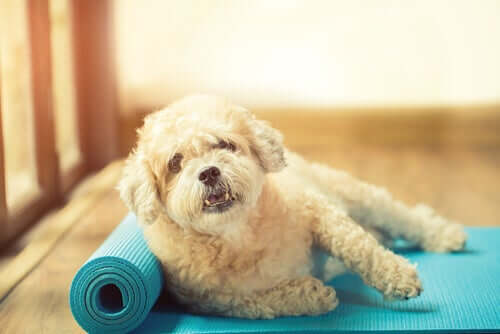All You Want To Know About Yoga for Dogs


Written and verified by the lawyer Francisco María García
Known as “doga”, this teaching consists of shared yoga sessions between dogs and their owners. It was created by a yogi, a person that practices yoga, who noticed interest in his dog as it followed along with the routine.
Those who practice “doga” compare the activity to doing yoga along with babies. When practicing yoga, both owners and their animals benefit from the virtues of this doctrine. While a great deal of skepticism exists around the issue, it’s a growing trend around the world. In fact, it’s already popular among artists and celebrities.
Can dogs really do yoga?
There are certain animals that are flexible by nature, such as cats. In yoga, participants practice stretches that are natural for animals, and this is exactly what our pets find attractive.

When it comes to dogs, their ability to get involved in the activities of their owners is common knowledge. This includes habits and activities in which their owners participate.
The same is true for yoga for dogs. Doga takes advantage of these animals’ interest in being part of their owners’ routines. It consists of a session that the owner leads, and both parties share some of the yoga positions. What’s more, the practice involves breathing and stretching techniques.
What does the routine consist of?
Doga sessions depend on the animal’s ability and willingness. They may last between 30 minutes and an hour, and there are even those who prefer to do various shorter sessions throughout the day.
It’s best to choose a peaceful spot where you can carry out sessions. That being said, dogs can do yoga wherever their owner indicates. Of course, the fewer distractions, the better, so that both participants can concentrate.
The way that owners should introduce their dogs to this practice is gradual. The first attempts should consist more of play than of a discipline. This is the best method for beginner dogs.
At the same time, you should invite your dog to the yoga area and begin by petting its back. Then, you should follow with some exercises to stretch your dog’s extremities.
Never force your dog’s stretching, as this can lead to injury. Rather, make sure that exercises are mild and delicate. Depending on the breed, some canines are more flexible than others.
The benefits of doga, or yoga for dogs
Specialists assure us that the benefits for dogs are the same as those for humans. In other words, this discipline helps them to relax, as they reduce their levels of stress and anxiety.
Yoga for dogs also improves circulation and posture and helps with sleep disorders. Another important benefit is that doga reduces the effects associated with canine depression and phobias.
What’s more, thanks to the stretching techniques, animals learn to stretch their muscles. Therefore, yoga for dogs helps to prevent the appearance of pulled muscles. And, on an emotional level, doga is beneficial for a dog’s character.
But the greatest benefit of yoga for dogs is the increased rapport between dog and owner. Yoga strengthens the bonds between both parties and makes room for a connection between both participants.

Some recommendations regarding yoga for dogs
Just like any other discipline, it’s best to see a veterinarian before you introduce your pet to doga. A professional will evaluate the physical condition of your pet as well as your pet’s capacity for exercise.
In fact, it’s best to have a specialist lead the first sessions. If you can’t attend a doga class, then you can look for different routines on the internet.
It’s important to point out that sessions led by professionals offer tools for handling pets during the activity. They also employ techniques to relax animals and encourage them to participate.
Once you’ve mastered this doctrine and its techniques, you can start personalizing your routines. It’s best to focus on the positions that your dog enjoys the most and feels most comfortable performing.
After each session, it’s important that animals drink plenty of water. Though it may not seem like it, yoga is a complete exercise, meaning that the body stays warm for a long period of time. For the same reason, you should wait for a while before bathing your dog.
Finally, if your dog complains or seems uncomfortable, you should see a veterinarian. Although most vets believe in the benefits of doga, some warn of the possible injury that can occur when stretching.
This text is provided for informational purposes only and does not replace consultation with a professional. If in doubt, consult your specialist.